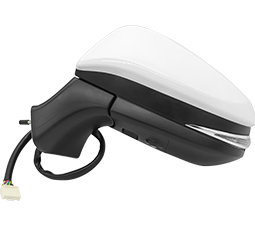2025-10-23
Auto side mirrors are crucial for safe driving, providing visibility of vehicles and obstacles alongside your car. However, in cold or humid weather, condensation or frost can form on the mirror surface, reducing visibility and increasing the risk of accidents. Heated auto side mirrors are designed to prevent fogging and frost by warming the mirror surface, ensuring clear vision regardless of environmental conditions.
Understanding how heated mirrors work and their benefits can help drivers make informed decisions when purchasing or maintaining vehicles, especially in regions with frequent fog, rain, or snow.
Heated auto side mirrors use an integrated heating element behind the mirror glass to generate warmth. This element is typically powered by the vehicle’s electrical system. When activated, it warms the mirror surface, preventing condensation from forming and melting frost in colder temperatures. Most modern vehicles allow drivers to activate the mirror heating system through a button or it may automatically operate when the rear defroster is engaged.
The heating element is usually a thin wire or film embedded in the mirror glass. It converts electrical energy into heat efficiently, distributing warmth evenly across the mirror surface. This ensures that the entire mirror remains clear, rather than only partially heated, which could leave blind spots.
Most heated mirrors are linked to the vehicle’s climate control system or rear defroster. When the system detects low temperatures or high humidity, it can automatically activate the heating element. In some vehicles, drivers can manually control the heating feature, providing flexibility for different weather conditions and personal preferences.
Heated auto side mirrors offer multiple advantages, improving both convenience and safety:
Heated mirrors can be original equipment on many modern vehicles, but they can also be added as aftermarket upgrades. The installation method may vary depending on the type of mirror and vehicle model.
Many manufacturers include heated mirrors in premium or winter packages. These mirrors are integrated into the vehicle’s electrical system and designed to function seamlessly with other climate control features. They are generally more reliable and durable compared to aftermarket options.
For older vehicles or models without factory heating, aftermarket kits can be installed. These typically involve replacing the mirror glass with a heated unit or attaching a heating film to the existing mirror. Professional installation is recommended to ensure electrical connections are safe and effective.
Although heated mirrors are generally reliable, some issues may arise:
Proper care ensures the longevity and functionality of heated mirrors. Key tips include:
Heated auto side mirrors are a valuable feature that enhances driving safety and convenience by preventing fogging and frost accumulation. By understanding the technology behind them, their benefits, and proper maintenance, drivers can ensure clear visibility in all weather conditions. Whether factory-installed or added as an aftermarket upgrade, heated mirrors contribute significantly to safer and more comfortable driving experiences, especially in cold or humid environments.
